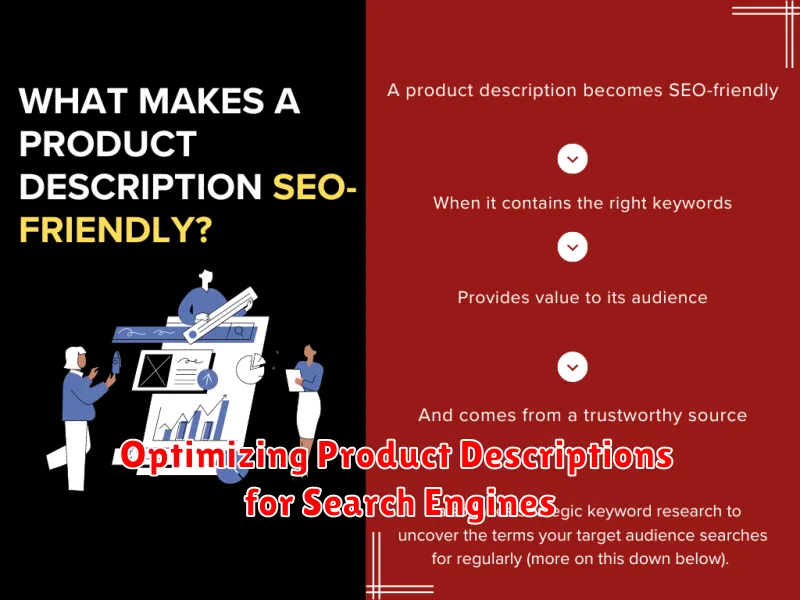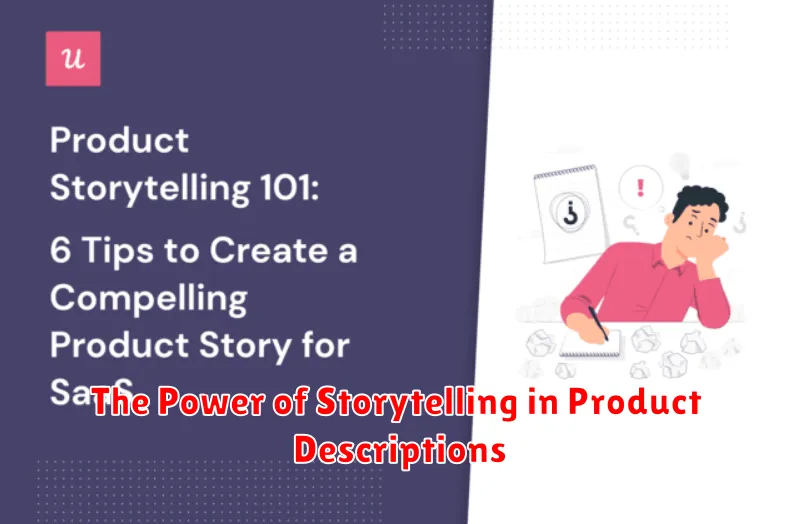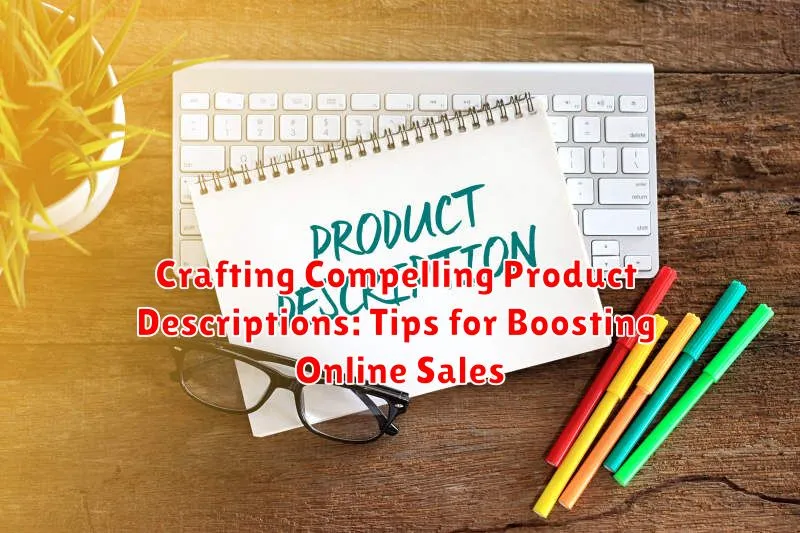In today’s competitive e-commerce landscape, crafting compelling product descriptions is paramount to success. A well-written product description can be the deciding factor between a conversion and a bounce. It’s more than just listing features; it’s about weaving a narrative that resonates with your target audience, highlighting the benefits of your product, and ultimately, boosting online sales. This comprehensive guide delves into the art of crafting product descriptions that not only inform but also persuade, transforming casual browsers into enthusiastic buyers.
Discover the secrets to creating product descriptions that captivate and convert. From understanding your target audience to mastering the art of persuasive language, this article provides actionable tips and strategies for optimizing your product descriptions to drive online sales. Learn how to showcase your products in the best possible light, emphasizing their unique value proposition and leaving a lasting impression on potential customers. Unlock the power of compelling content and transform your product pages into powerful sales engines.
Understanding the Importance of Product Descriptions
Product descriptions are arguably the most crucial piece of content on a product page. They bridge the gap between simply showcasing a product and persuading a customer to buy it. Effective descriptions go beyond simply listing features; they tell a story, answer key questions, and ultimately drive conversions.
Without compelling descriptions, potential customers are left with unanswered questions, leading to uncertainty and abandoned carts. Clarity and conciseness are key. Customers need to quickly grasp the product’s value proposition and how it solves their needs. A well-crafted description instills confidence and encourages purchase decisions.
Furthermore, strong descriptions contribute to a positive user experience. They provide essential information upfront, reducing customer service inquiries and returns. This in turn boosts customer satisfaction and brand loyalty.
Key Elements of a Compelling Product Description
A compelling product description is built upon several key elements working together harmoniously. A clear and concise product title is paramount, accurately reflecting the item while capturing attention. This should be immediately followed by a brief, impactful summary highlighting the product’s core value proposition.
The detailed description delves into specifics, addressing key features and functionalities. High-quality product images complement the text, showcasing the item from various angles and highlighting important details. Finally, specifications provide technical information, such as dimensions, materials, and care instructions, enabling informed purchase decisions.
Writing for Your Target Audience
Understanding your target audience is crucial for crafting effective product descriptions. Writing a description that resonates with your ideal customer increases the likelihood of a purchase. Consider their demographics, interests, needs, and pain points.
Speak their language. Avoid jargon or technical terms they might not understand. If your target audience is tech-savvy, technical details might be appropriate. Conversely, if you’re targeting a broader audience, keep the language simple and accessible.
Address their needs. Focus on how the product solves their problems or improves their lives. What benefits will they experience by using your product? Clearly communicate the value proposition.
Match their tone and style. Are they looking for a formal and informative description or a more casual and friendly approach? Mirroring their preferred style builds rapport and trust.
Using Keywords Effectively in Product Descriptions
Keywords are the terms and phrases that potential customers use when searching for products online. Effectively incorporating relevant keywords into your product descriptions is crucial for improving search engine visibility and driving organic traffic to your product pages.
Start by conducting keyword research to identify the terms most commonly used by your target audience. Tools like Google Keyword Planner can help you discover valuable keywords with high search volume and low competition. Once you’ve identified relevant keywords, strategically integrate them throughout your product description.
Avoid keyword stuffing, which is the practice of overusing keywords in an attempt to manipulate search engine rankings. This can negatively impact your SEO and create a poor user experience. Instead, focus on using keywords naturally and organically within the context of your description.
Consider using long-tail keywords, which are longer, more specific phrases that often reflect the user’s search intent more accurately. For example, instead of using the keyword “shoes,” you might use “women’s running shoes for trail running.”
Highlighting Benefits and Features
Clearly showcasing both the features and benefits of your product is crucial for persuading potential customers. While features describe factual attributes, benefits explain how those attributes improve a customer’s life or solve a problem.
Features are the tangible aspects of your product. Think size, materials, color options, technical specifications, etc. For example, a feature of a laptop might be a “1TB SSD hard drive.” This is a concrete, measurable attribute.
Benefits, on the other hand, translate features into value for the customer. Instead of simply stating the laptop has a “1TB SSD,” highlight the benefit: “Store thousands of photos and videos with the expansive 1TB SSD hard drive.” This demonstrates the positive impact of the large storage capacity.
When crafting your descriptions, weave together features and benefits for maximum impact. Start by stating the feature and immediately follow up with the benefit it provides. This approach allows customers to quickly understand the value proposition of your product and encourages them to make a purchase.
Creating a Sense of Urgency
Creating a sense of urgency in your product descriptions can significantly boost sales by encouraging immediate purchases. Customers are more likely to buy a product if they feel they might miss out.
Several tactics can effectively create this urgency. Limited-time offers, such as sales or discounts, are powerful motivators. Phrases like “limited-time offer” or “sale ends soon” explicitly communicate scarcity.
Highlighting limited quantities also creates urgency. Statements like “only a few left” or “while supplies last” suggest that the product is in high demand and may soon be unavailable.
Another effective technique is using time-sensitive language. Phrases like “order now to receive by [date]” or “don’t miss out on this offer” encourage immediate action.
Tips for Writing Clear and Concise Descriptions
Clarity and conciseness are crucial for effective product descriptions. Consumers should quickly understand what the product is and its key features.
Start by knowing your target audience. Use language they understand and avoid technical jargon unless it’s absolutely necessary. Focus on the benefits of the product, not just the features. Explain how the product will improve the customer’s life or solve a problem they face.
Use short sentences and bullet points to break up large blocks of text. This improves readability and allows customers to quickly scan for important information. Avoid unnecessary adverbs and adjectives that clutter the description without adding value.
Proofread carefully for any grammatical errors or typos. A poorly written description can damage your brand’s credibility. Focus on delivering accurate information to avoid misleading potential customers.
Optimizing Product Descriptions for Search Engines

Optimizing your product descriptions for search engines is crucial for driving organic traffic and increasing visibility. By incorporating relevant keywords, you can improve your product’s ranking in search results. Keyword research is the first step, identifying the terms your target audience uses when searching for products like yours.
Naturally integrate these keywords within your descriptions. Avoid keyword stuffing, which can negatively impact your ranking. Focus on creating informative and engaging content that also incorporates these key search terms.
Use descriptive product titles rich with relevant keywords. This helps search engines understand what your product is and who it’s for. Consider using long-tail keywords (longer, more specific phrases) to target niche searches.
Optimize image alt text with descriptive keywords. While this section focuses on text, image optimization complements your description and aids search engine understanding of your product’s visual aspects.
A/B Testing Your Product Descriptions
A/B testing, also known as split testing, is a crucial step in optimizing your product descriptions for conversions. It involves creating two different versions of a description (version A and version B) and showing them to separate groups of potential customers. By analyzing the performance of each version, you can determine which resonates more effectively with your target audience.
When A/B testing your descriptions, focus on key elements such as: the product title, the main body text highlighting benefits, the call to action, and even the formatting (e.g., bullet points vs. paragraphs). Track metrics like click-through rates, conversion rates, and average order value to understand the impact of each variation.
Remember to test only one element at a time. This isolates the impact of that specific change and provides clearer insights into what’s working and what’s not. For example, test different headlines while keeping the body text constant, then test variations in the body while maintaining the chosen headline.
Continuously iterating and refining your descriptions through A/B testing will lead to progressively improved performance and increased sales.
The Power of Storytelling in Product Descriptions

Storytelling can transform product descriptions from mundane lists of features into engaging narratives that resonate with customers. By weaving a compelling narrative around your product, you can connect with buyers on an emotional level, fostering desire and increasing the likelihood of a purchase. Instead of simply stating what a product is, storytelling focuses on what a product does for the customer.
Consider incorporating these elements to effectively leverage storytelling:
- Character: Who is the ideal customer for this product? Describe their needs and aspirations.
- Setting: Where and how will the customer use this product? Paint a picture.
- Plot: How does the product solve the customer’s problem or fulfill their desire? Show the transformation.
- Conflict: What challenges does the customer face without the product? Highlight the pain points.
- Resolution: How does the product provide the solution? Showcase the benefits and value.
By strategically incorporating these narrative elements, you can create product descriptions that captivate readers and drive conversions.

